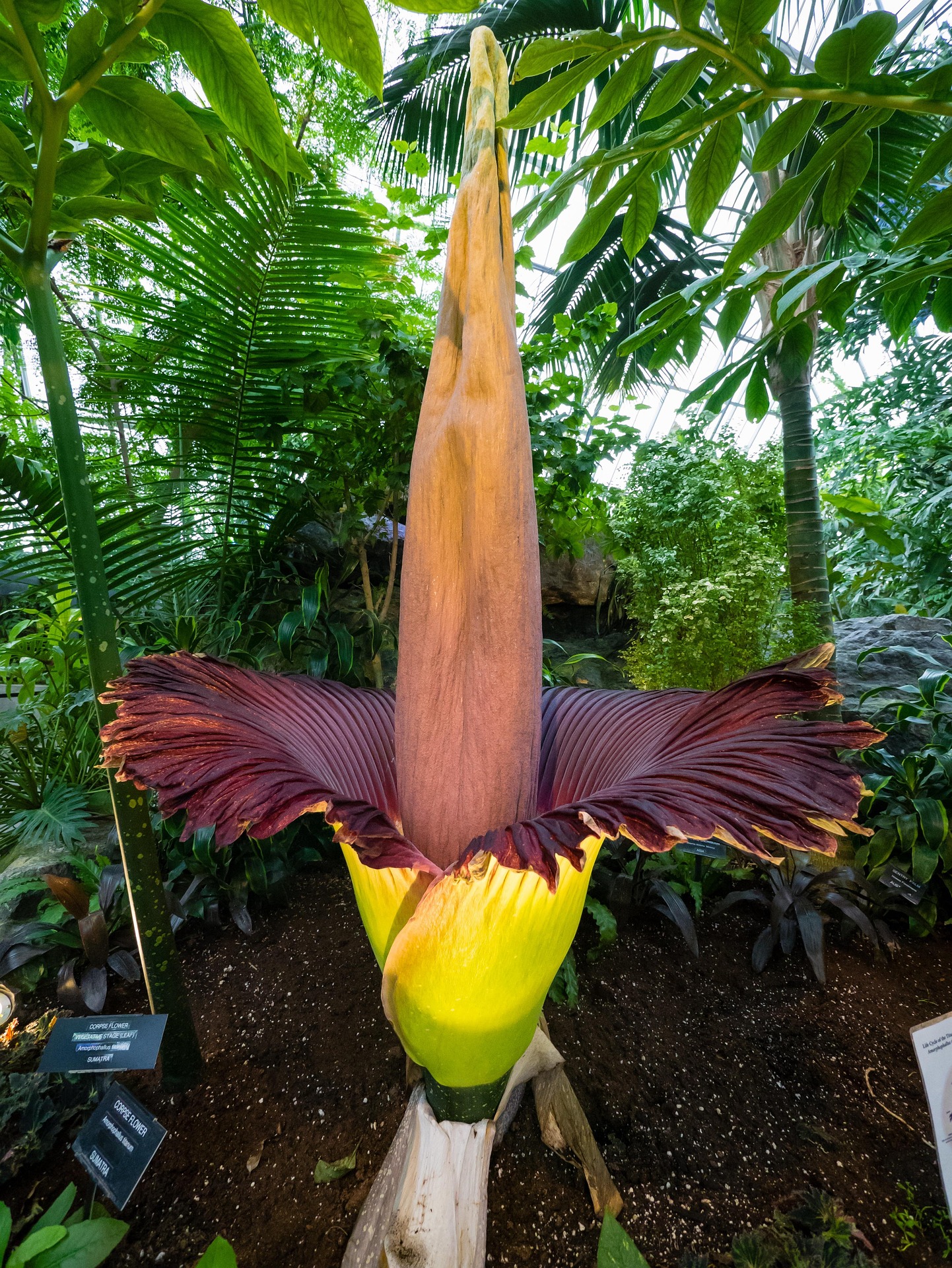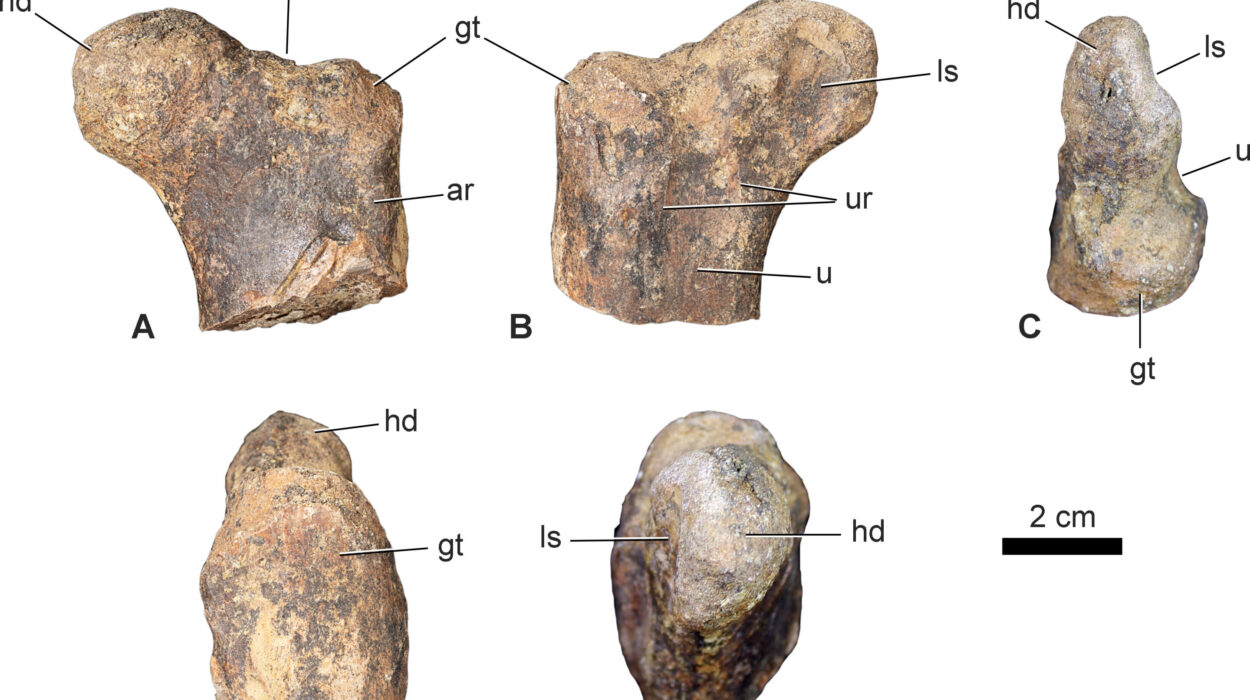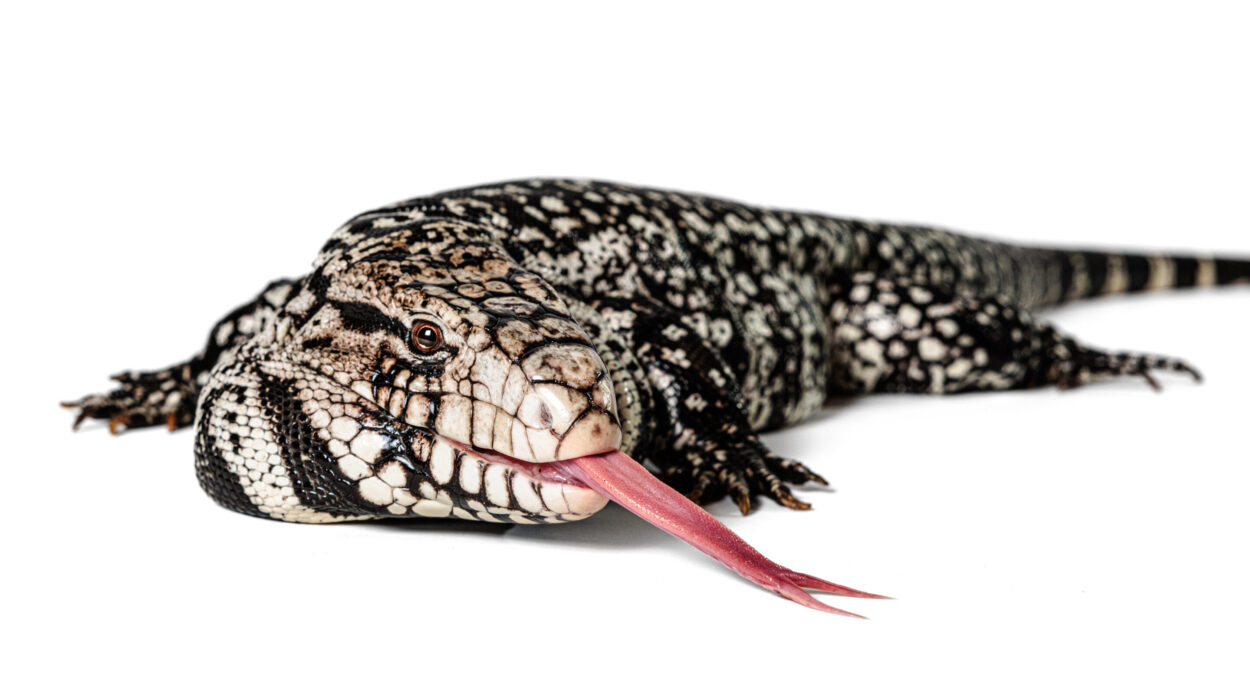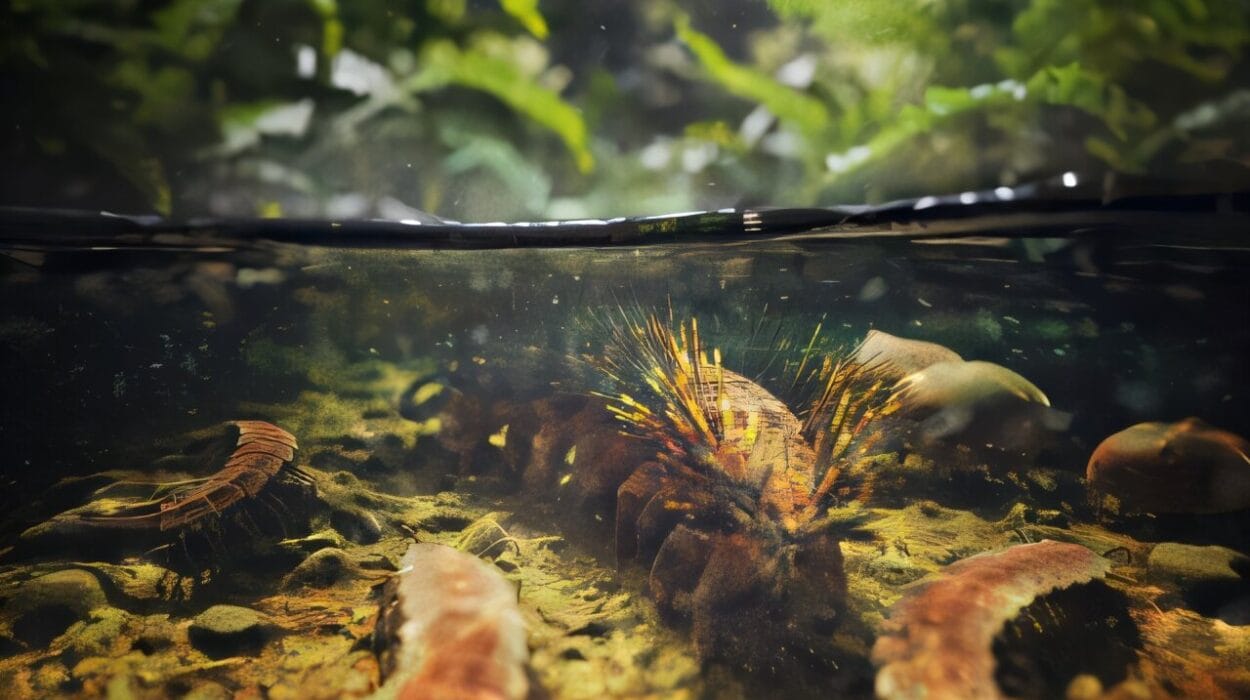On a humid night in the dense jungles of Sumatra, an ancient plant prepares for one of the rarest spectacles in the natural world. The corpse flower, or Amorphophallus titanum, rises from the earth like a monstrous, alien creature, its spadix soaring upwards as high as 10 feet, crowned by a reddish-purple sheath. It’s a dramatic, unsettling sight—a flower that seems to defy nature’s usual expectations of beauty. Its pungent odor, thick and fetid, hangs in the air, a stench that turns the stomach, evoking memories of rotting flesh and decaying carrion.
This is not the romantic scent of roses or jasmine, nor the inviting fragrance of lilies. No, the corpse flower has only one purpose, and that is to attract an audience of a very specific kind. Beneath its ghastly appearance lies a brilliant strategy that has evolved over millions of years. This plant, both revered and reviled, represents nature’s unsettling genius—a mixture of bizarre beauty and the harshness of survival in its most primal form.
It’s an understatement to say that the corpse flower is an anomaly in the botanical world. There is no other flower quite like it. Its towering size, its rare blooming pattern, and its grotesque aroma make it a symbol of the strange extremes that life on Earth can reach when it adapts in ways that challenge our very understanding of nature.
A Phenomenon That Stuns the World
In the world of botany, the corpse flower is a rock star. When one blooms in a public garden or botanical institution, it draws crowds like a festival. The bloom lasts only for 48 hours, making it an incredibly rare event to witness. This brief flowering period is an emotional rollercoaster for visitors and botanists alike: months, sometimes years, of anticipation climax in a fleeting moment of otherworldly beauty—or, depending on how you view it, horror.
On one particular occasion, the world watched in awe as a corpse flower at the United States Botanic Garden in Washington D.C. bloomed in 2017. A livestream broadcasted the event, and the internet buzzed with excitement and curiosity. People flocked to the garden to witness the plant’s striking transformation from a bud to a full-fledged flower. They held their breath, waiting for the perfume to take hold, knowing that the stench would not disappoint. What the crowd witnessed was nothing short of a miracle in the plant world—a spectacle that was more than just an uncommon flower blooming. It was the rare convergence of beauty, biology, and bizarre strategy.
But what makes this plant so extraordinary? To understand its true genius, we must dig deeper into its biology, its bizarre lifestyle, and its peculiar evolutionary history.
The Corpse Flower’s Anatomy: An Ode to Oddity
The corpse flower is not a single flower but rather a compound structure made up of several parts. Its most striking feature is the enormous spadix, the fleshy, cylindrical structure that emerges from the base. At its peak, the spadix can reach up to 10 feet in height, making it one of the largest unbranched inflorescences in the world.
Surrounding this spadix is a large, leaf-like structure called the spathe. It’s the deep purple, almost maroon, “hood” that wraps around the spadix like a blanket. When the flower is ready to bloom, the spathe unfurls like a curtain drawing back on a stage. Its appearance is often compared to a creature from a prehistoric age—an archaic form of life whose very existence seems to violate the rules of modern-day aesthetics.
But what really sets the corpse flower apart, the factor that both fascinates and repels, is the odor. As the bloom opens fully, it releases a scent so foul, so offensive, that even the most seasoned botanists and horticulturists struggle to describe it. It’s a blend of rotting meat, decaying fish, and excrement—an olfactory assault on the senses. This powerful stench is produced by chemicals such as dimethyl trisulfide and trimethylamine, which are known to be emitted by decomposing animals.
The reason behind this revolting aroma lies in the plant’s unique method of pollination. Unlike many flowers that attract pollinators with sweet fragrances, the corpse flower relies on a far more macabre strategy: it lures scavenging insects, such as flies and beetles, that feed on decaying organic matter. These insects are drawn to the smell, mistaking it for a source of food or a place to lay their eggs. When they visit the flower, they inadvertently pollinate it, spreading pollen from one flower to another.
Incredibly, the plant’s odor is not constant. It follows a cycle, beginning with a peak in intensity in the early hours of blooming, when the scent is most pungent. Over the next day or so, the stench gradually fades, and the flower begins to wilt. After a very short-lived existence, it shrivels up and disappears, leaving behind only the memory of its unsettling presence.
An Evolutionary Marvel: The Corpse Flower’s Origins
The corpse flower is part of a plant family called Araceae, which includes the familiar houseplant, the peace lily. Within this family, the Amorphophallus genus is particularly well-known for its bizarre and grotesque flowers. However, the corpse flower, Amorphophallus titanum, is the undisputed crown jewel.
The species was first discovered in 1878 by the Italian botanist Odoardo Beccari, who encountered it in the rainforests of Sumatra, Indonesia. Its discovery in the wild was a revelation, and it quickly became the subject of scientific study. But it wasn’t until the flower began to be cultivated in European and American botanical gardens that it truly became a global sensation.
The plant’s evolution is a fascinating tale. Over millions of years, Amorphophallus titanum has developed this unusual reproductive strategy. By attracting scavenging insects, it benefits from pollinators that are often hard to come by for many other plants. In its native habitat, where competition for pollinators is fierce, the corpse flower has carved out a niche as a master of deception. Its bloom is a flash of spectacle in an otherwise quiet, leafy world.
But why such an extreme strategy? The answer likely lies in the environment in which the corpse flower thrives. The tropical rainforests of Sumatra are home to a wide variety of pollinators, but also countless plants competing for those pollinators’ attention. To stand out, the corpse flower needed a method that would ensure its pollination would not be overlooked. By mimicking the scent of decay, the plant taps into an underutilized resource—the flies and beetles that thrive in the decomposing matter of the forest floor. It’s an evolutionary gamble, but one that has worked remarkably well.
The Enigma of the Corpse Flower’s Blooming Cycle
The corpse flower’s blooming pattern is nothing short of mysterious. Unlike most plants, which flower annually or seasonally, the corpse flower’s blooming is erratic. Some plants bloom after a few years of growth, while others may wait for decades before they produce their first flower. The plant’s life cycle is marked by long periods of dormancy, where it grows a single, massive leaf that can span several feet in diameter, only to wither away before the next bloom.
In fact, a corpse flower’s first bloom can take anywhere from 7 to 10 years. During this time, the plant focuses all its energy on growing a massive tuber beneath the soil. This tuber can weigh several hundred pounds, storing nutrients that will fuel the flower’s rare and dramatic emergence. When it finally does bloom, the process takes place over a very short window, sometimes as brief as 24 to 48 hours. The timing of this event is an intricate dance with nature’s rhythms, dependent on temperature, humidity, and environmental conditions. It’s as though the plant knows exactly when to unveil its grotesque majesty for the briefest of moments, offering its spectacular (and stinky) gift to the world.
Botanists have studied these blooms meticulously, even using technology like infrared cameras to monitor the temperature fluctuations of the spadix during its bloom. Interestingly, the corpse flower generates heat during the blooming process, an additional tactic to help spread its odor over a wider area. This warmth, combined with the repellent odor, helps it attract more pollinators that might be further afield in the dense forest.
It’s a brilliant biological strategy—one that demonstrates the plant’s adaptability and ingenuity in surviving a hostile world. But as with many natural wonders, there’s a sense of irony in the corpse flower’s success. Its beauty, in a sense, is fleeting, existing only for a brief moment in time before it vanishes into the wilderness once again.
The Corpse Flower in Popular Culture
The corpse flower’s appeal extends far beyond botany. It has captured the imaginations of artists, filmmakers, and even horror enthusiasts. Its nightmarish appearance, its smell, and its sheer size have made it a perfect subject for creative minds interested in exploring the eerie, the strange, and the fantastical. It has been featured in documentaries, books, and even horror films that examine the wonders and horrors of the natural world.
Its association with death and decay has also made it a potent symbol. The corpse flower is a stark reminder of the natural processes that sustain life—growth, decay, and the inevitability of death. It is both a metaphor for the passage of time and a symbol of the unfathomable mysteries of the planet we call home.
In many ways, the corpse flower is a reflection of humanity’s relationship with nature itself. We are drawn to the strange, the rare, the beautiful, and the grotesque. The corpse flower reminds us that life on Earth is not always tidy, not always pretty, but it is always awe-inspiring in its creativity and complexity.
The Lasting Legacy of the Corpse Flower
The corpse flower continues to intrigue and inspire, reminding us that the natural world holds secrets far beyond our grasp. It challenges our assumptions about beauty, smell, and the ways in which life can survive in a world filled with competition and peril. Its rare and unsettling bloom is a testament to the resilience of life itself, to the incredible ways in which plants adapt to their environment, and to the eerie allure of the unknown.
In a world that often seeks the aesthetically pleasing and the easily understandable, the corpse flower stands as a stark reminder that nature operates on its own terms. It is neither evil nor good, neither beautiful nor ugly. It is simply a master of survival, a brilliant, creepy genius that thrives by being exactly what it needs to be.
The next time you hear about a corpse flower blooming somewhere in the world, consider the delicate dance it performs—one that has taken millions of years to perfect. And perhaps, in the distance, you’ll smell the faint scent of decay, a reminder of nature’s strange genius.






